Global Point Of Care
RELEVER LES DÉFIS LIÉS À L’ÉVALUATION D’UNE SUSPICION DE TRAUMATISME CRÂNIEN LÉGER (TCL)
À L’AIDE DU TEST i-STAT TBI PLASMA UTILISÉ AVEC L’i-STAT ALINITY SYSTEM
Le test i-STAT TBI Plasma n’est pas destiné à une utilisation en tant que dispositif de biologie délocalisée



Relever Les Défis Liés À L’ÉVALUATION D’Une Suspicion De Traumatisme Crânien Léger (TCL)
À L’AIDE DU TEST i-STAT Tbi Plasma Utilisé Avec L’i-STAT ALINITY SYSTEM
Le test i-STAT TBI Plasma n’est pas destiné à une utilisation en tant que dispositif de biologie délocalisée



RELEVER LES DÉFIS LIÉS À L’ÉVALUATION D’UNE SUSPICION DE TRAUMATISME CRÂNIEN LÉGER (TCL)
À L’AIDE DU TEST i-STAT TBI PLASMA UTILISÉ AVEC L’i-STAT ALINITY SYSTEM
Le test i-STAT TBI Plasma n’est pas destiné à une utilisation en tant que dispositif de biologie délocalisée



LES MÉTHODES ACTUELLES POUR L’ÉVALUATION DES SUSPICIONS DE TCL PEUVENT ÊTRE SUBJECTIVES
Chaque année, des millions de patients sont examinés aux urgences pour un TCL. Mais le score de Glasgow (GCS) et le bilan clinique ne fournissent que des informations subjectives, ce qui incite de nombreux praticiens à prescrire un scanner.
Le test i-STAT TBI Plasma peut représenter la solution pour éviter le recours chronophage et souvent inutile aux scanners cérébraux pour diagnostiquer un TCL.1
Les Méthodes Actuelles Pour L’évaluation Des Suspicions De Tcl Peuvent Être Subjectives
Chaque année, des millions de patients sont examinés aux urgences pour un TCL. Mais le score de Glasgow (GCS) et le bilan clinique ne fournissent que des informations subjectives, ce qui incite de nombreux praticiens à prescrire un scanner.
Le test i-STAT TBI Plasma peut représenter la solution pour éviter le recours chronophage et souvent inutile aux scanners cérébraux pour diagnostiquer un TCL.1
Les Inconvénients Du Scanner
Le Scanner Prescrit Pour Les Tcl Présente Un Faible Rendement Diagnostique - Et Des Inconvénients Majeurs
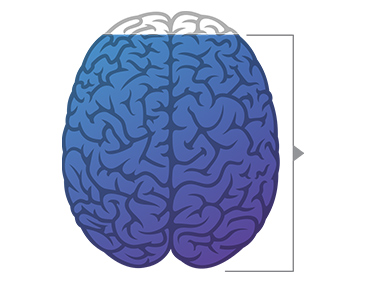


Les règles de décision clinique (RDC), telles que la Canadian CT Head Rule, ont eu un effet limité sur le nombre de scanners ou le rendement diagnostique du scanner dans l’évaluation des TCL3-5
82 % environ des patients souffrant d'un traumatisme crânien léger passent un scanner, mais > 90 % ne présentent aucun signe d’anomalie traumatique1
Un examen systématique de 14 études a révélé que parmi les patients souffrant d'un traumatisme crânien mineur, seulement 7 % d'entre eux présentaient des lésions intracrâniennes sévères visibles au scanner, tandis que < 1 % présentaient des lésions nécessitant une intervention neurochirurgicale2
EN TANT QU’OUTIL D’Évaluation Des Suspicions De Tcl, Le Scanner Présente Des Inconvénients Majeurs
- Le délai entre la prescription d'un scanner et la lecture des résultats peut prendre jusqu’à 3 heures, soit environ la moitié du temps total d’évaluation d’un TCL6
- Les doses absorbées par les organes au cours d'un scanner sont considérablement plus élevées que celles d’une radiographie traditionnelle7
- La dose absorbée, ou dose radioactive, lors d'un scanner cérébral équivaut à 100 fois la dose émise pendant une radiographie du thorax
- Les patients difficiles à évaluer, en état d'ébriété ou sous l’emprise de stupéfiants par exemple, posent problème
BIOMARQUEURS DES TCL
LES BIOMARQUEURS DU TRAUMATISME CRÂNIEN PEUVENT RÉDUIRE LE NOMBRE DE SCANNERS INUTILES POUR LES SUSPICIONS DE TCL
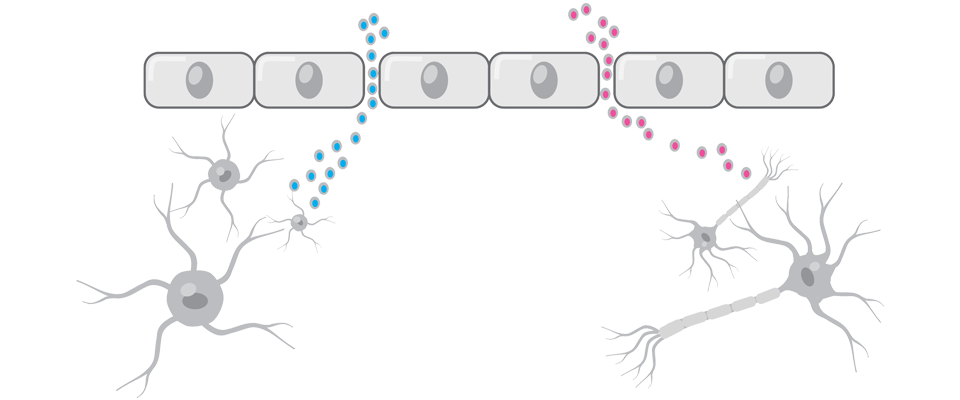
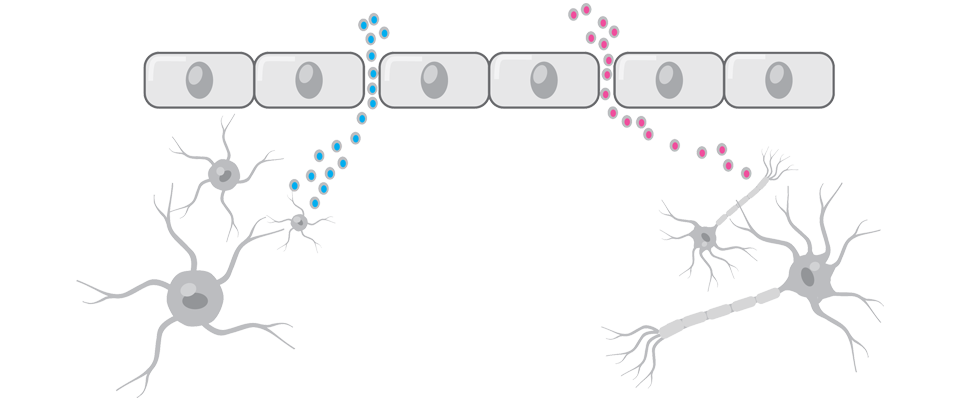

SUITE À UN TRAUMATISME CRÂNIEN, LA PERMÉABILITÉ ET LA FUITE DE MOLÉCULES À TRAVERS LA BARRIÈRE HÉMATO-ENCÉPHALIQUE AUGMENTENT8,9
Les protéines membranaires qui franchissent la barrière hémato-encéphalique lorsque celle-ci est détériorée peuvent servir de biomarqueurs d’un traumatisme crânien.8
BIEN QUE PLUSIEURS BIOMARQUEURS DU TRAUMATISME CRÂNIEN AIENT ÉTÉ ÉTUDIÉS, CERTAINES CARACTÉRISTIQUES SONT JUGÉES INDISPENSABLES POUR QU'ILS AIENT UNE VALEUR DIAGNOSTIQUE AUX URGENCES :10:
- Facilement mesurables dans un fluide biologique accessible, comme le sang périphérique, peu de temps après le traumatisme
- Taux élevés de sang périphérique caractéristiques des traumatismes crâniens
- Sensibilité suffisamment élevée pour évaluer un traumatisme léger
LE TEST i-STAT TBI PLASMA
PRÉSENTATION DU Test i-STAT TBI PLASMA, UN DOSAGE AXÉ SUR LES BIOMARQUEURS, CONÇU POUR UNE ÉVALUATION OBJECTIVE DE LA NÉCESSITÉ D’UN SCANNER
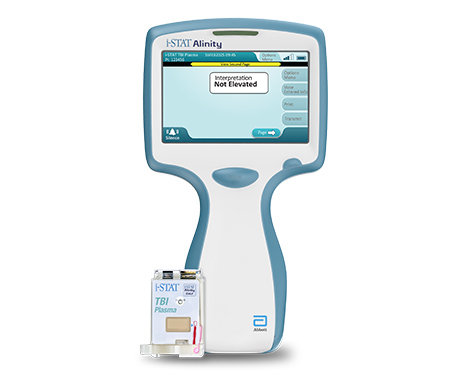


Le test i-STAT TBI Plasma associe deux dosages pour les biomarqueurs spécifiques au cerveau, la protéine acide fibrillaire gliale (GFAP) et l’ubiquitine carboxyl-terminale hydrolase L1 (UCH-L1), dans un seul test multiplex conçu pour déterminer le besoin d’un scanner cérébral.11
UTILISATION PRÉVUE11
L’interprétation des résultats des tests est utilisée, conjointement avec d’autres informations cliniques, pour faciliter l’évaluation des patients, âgés de 18 ans ou plus, qui présentent une suspicion de TCL (score de Glascow entre 13 et 15) dans les 12 heures suivant le traumatisme afin de déterminer la nécessité de réaliser un scanner cérébral.*
*Le test i-STAT TBI Plasmadoit être utilisé avec du plasma préparé par un professionnel de santé à partir d’échantillons prélevés sur anticoagulant (EDTA, acide éthylènediaminetétraacétique) dans un laboratoire clinique. Il n’a pas vocation à être utilisé en biologie délocalisée.
LE TESTi-STAT TBI PLASMA RÉDUIT L’INCERTITUDE EN FOURNISSANT UNE ÉVALUATION QUANTIFIABLE ET OBJECTIVE POUR CONFIRMER OU INFIRMER UNE SUSPICION DE TCL
- Avec une valeur prédictive négative (VPN) de 99,3 % dans l’étude pivot, le test i-STAT TBI Plasma peut réduire le recours à l'imagerie scanner, et donc potentiellement l’exposition inutile aux rayonnements, la durée du séjour et la mobilisation des ressources pour les patients qui ne présentent pas de risque d’anomalie au scanner11
- La sensibilité clinique élevée et la VPN du test i-STAT TBI Plasma aident à prendre des décisions en toute confiance pour la sortie sans danger des patients, sans passer de scanner



*Le test i-STAT TBI Plasma doit être utilisé avec du plasma préparé par un professionnel de santé à partir d’échantillons prélevés sur anticoagulant (EDTA) dans un laboratoire clinique. Il n’a pas vocation à être utilisé en biologie délocalisée.
VOUS SOUHAITEZ EN APPRENDRE DAVANTAGE SUR L’i-STAT ALINITY SYSTEM ?
LE TESTi-STAT TBI PLASMA PEUT FAIRE BAISSER DE 40 % LE NOMBRE DE SCANNERS INUTILES POUR UNE SUSPICION DE TCL
40,4 % des résultats négatifs de l’étude pivot donnaient un vrai résultat négatif sur le test i-STAT TBI Plasma, suggérant une réduction potentielle de 40 % des scanners inutiles11,12
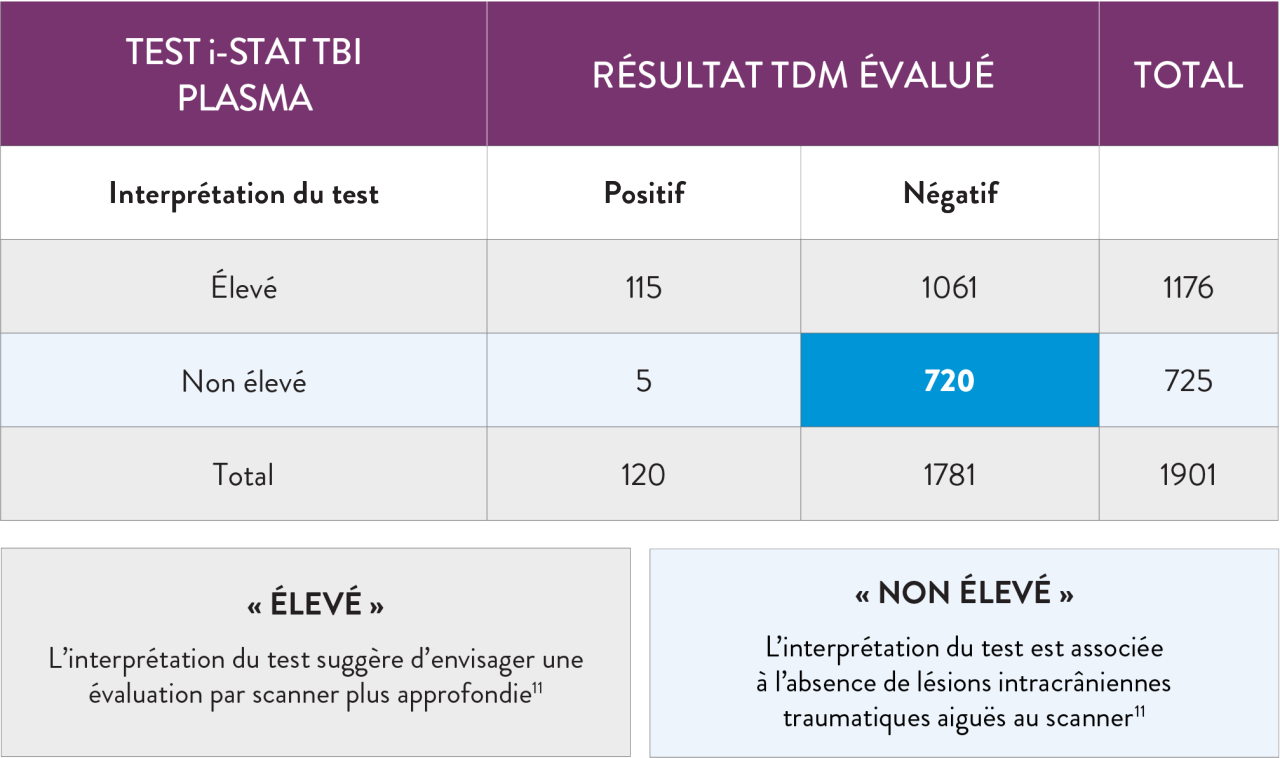


LA RÉDUCTION DU NOMBRE DE SCANNERS PEUT AVOIR DES IMPLICATIONS POSITIVES POUR LES FLUX DE TRAVAIL AUX URGENCES, LA MOBILISATION DES RESSOURCES ET LA SATISFACTION DES PATIENTS
POUR CHAQUE SCANNER ÉVITÉ, LES TEMPS D’ATTENTE, LA MOBILISATION DES RESSOURCES ET LES COÛTS ASSOCIÉS PEUVENT ÉGALEMENT ÊTRE ÉLIMINÉS
LA DÉLAI DE TRAITEMENT DE 15 MINUTES* DU TEST i-STAT TBI PLASMA PEUT PRÉSENTER DES AVANTAGES IMPORTANTS :
TEMPS D’ATTENTE ÉCOURTÉS
CONFIRMATION RAPIDE
SORTIE DANS LES MEILLEURS DÉLAIS
QUEL IMPACT UN DOSAGE DES BIOMARQUEURS POUVANT CONTRIBUER À EXCLURE DE MANIÈRE OBJECTIVE ET PRÉCISE LA NÉCESSITÉ D’UN SCANNER DANS LE DIAGNOSTIC D’UN TCL PEUT-IL AVOIR SUR VOTRE SERVICE DES URGENCES ?
LES BIOMARQUEURS DERRIÈRE LE TEST
LA GFAP ET L’UCH-L1 SONT DES BIOMARQUEURS SPÉCIFIQUES AU CERVEAU, PARFAITEMENT VALIDÉS ET COMPLÉMENTAIRES, LIBÉRÉS DANS LA CIRCULATION SANGUINE SUITE À UN TRAUMATISME CRÂNIEN À PARTIR DE DEUX TYPES DE CELLULES DIFFÉRENTS
LA GFAP EST UNE PROTÉINE STRUCTURELLE PRÉSENTE QUASI EXCLUSIVEMENT DANS LES ASTROCYTES13
- La GFAP est un marqueur spécifique des lésions astrocytaires dans la substance blanche ou grise, élevé chez les patients dont le scanner montre des anomalies intracrâniennes traumatiques11,14
- La GFAP distingue de manière fiable les patients présentant un TCL et ceux sans traumatisme crânien15
- Contrairement à certains biomarqueurs étudiés auparavant, les taux de GFAP ne sont pas affectés par les traumatismes extra-crâniens ou l’effort16-19
L’UCH-L1 EST UNE ENZYME IMPLIQUÉE DANS LA DÉGRADATION QUI S’EXPRIME FORTEMENT ET EXCLUSIVEMENT DANS LES NEURONES13
- Il a été démontré que les taux sanguins permettent de différencier les patients souffrant d’un TCL des patients indemnes20
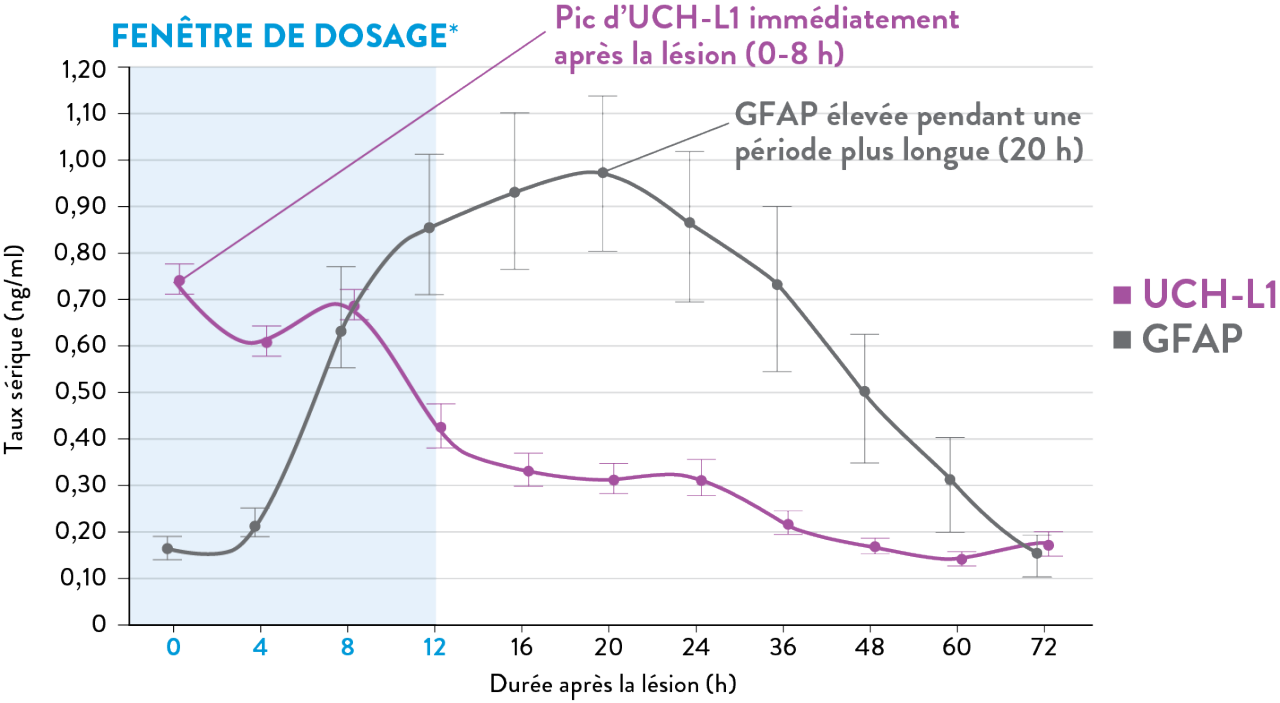
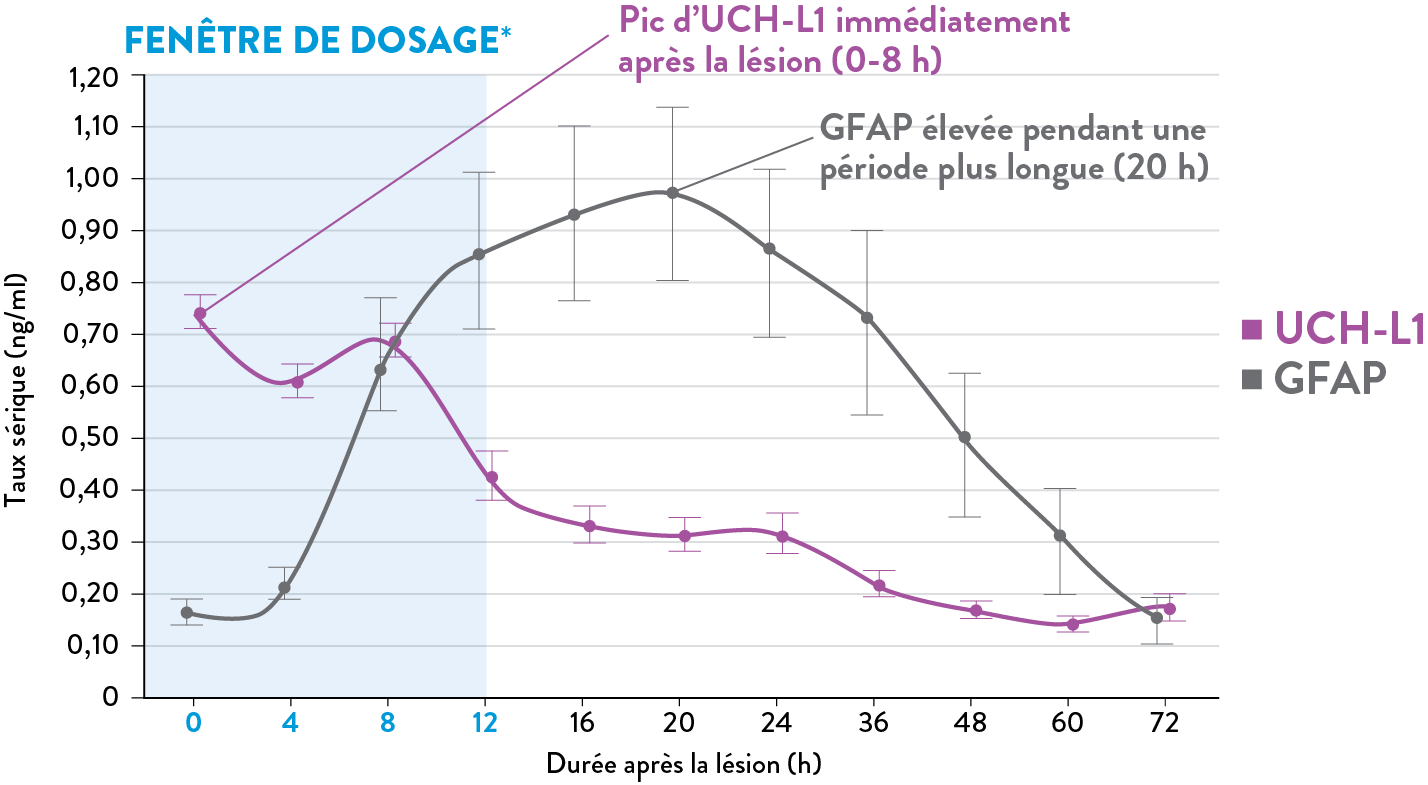

D’après Papa et al., 2016
Les taux sériques d’UCH-L1 atteignent un pic 0 à 8 heures après un traumatisme et diminuent régulièrement pendant 48 heures, tandis que la GFAP atteint son pic à 20 heures et diminue lentement 72 heures après un traumatisme crânien.21 Le test i-STAT TBI Plasma mesure les taux des deux biomarqueurs pendant la période optimale de 12 heures consécutive au traumatisme.11
*Le test i-STAT TBI Plasma doit être utilisé avec du plasma préparé par un professionnel de santé à partir d’échantillons prélevés sur anticoagulant (EDTA) dans un laboratoire clinique. Il n’a pas vocation à être utilisé en biologie délocalisée.
Références :
- Korley FK, Kelen GD, Jones CM, Diaz-Arrastia R. Emergency department evaluation of traumatic brain injury in the United States, 2009-2010. J Head Trauma Rehabil. 2016;31(6):379-387.
- Easter JS, Haukoos JS, Meehan WP, Novack V, Edlow JA. Will neuroimaging reveal a severe intracranial injury in this adult with minor head trauma? The Rational Clinical Examination Systematic Review. JAMA. 2015;314(24):2672-2681.
- Sharp AL, Nagaraj G, Rippberger EJ, et al. Computed tomography use for adults with head injury: describing likely avoidable emergency department imaging based on the Canadian CT Head Rule. Acad Emerg Med. 2017;24(1):22-30.
- Sultan HY, Boyle A, Pereira M, Antoun N, Maimaris C. Application of the Canadian CT head rules in managing minor head injuries in a UK emergency department: implications for the implementation of the NICE guidelines. Emerg Med J. 2014;21(4):420-425.
- Stiel IG, Clement CM, Grimshaw JM, et al. A prospective cluster-randomized trial to implement the Canadian CT Head Rule in emergency departments. JAMC. 2010;182(14):1527-1532.
- Michelson EA, Huff JS, Loparo M, et al. Emergency department time course for mild traumatic brain injury workup. West J Emerg Med. 2010;19(4):635-640.
- US Food and Drug Administration. What are the radiation risks from CT? Mis à jour le 5 décembre 2017. Consulté le 20 novembre 2020. https://www.fda.gov/radiation-emitting-products/medical-x-ray-imaging/what-are-radiation-risks-ct.
- Zetterberg H, Blennow K. Fluid biomarkers for mild traumatic brain injury and related conditions. Nat Rev Neurol. 2016;12(10):563-574.
- Chodobski A, Zink BJ, Symydynger-Chodobska J. Blood-brain barrier pathophysiology in traumatic brain injury. Transl Stroke Res. 2011;2(4):492-516.
- Wang KK, Yang Z, Zhu T, et al. An update on diagnostic and prognostic biomarkers for traumatic brain injury. Expert Rev Mol Diagn. 2018;18(2):165-180.
- Cassette i-STAT TBI Plasma. Mode d’emploi. Abbott Point of Care Inc. Abbott Park, IL ; 2020.
- Données internes. Abbott Point of Care Inc.
- Diaz-Arrastia R, Wang KKW, Papa L, et al; TRACK-TBI Investigators. Acute biomarkers of traumatic brain injury: relationship between plasma levels of ubiquitin C-terminal hydrolase-L1 and glial fibrillary acidic protein. J Neurotrauma. 2014;31(1):19-25.
- Metting Z, Wilczak N, Rodiger LA, Schaaf JM, van der Naalt J. GFAP and S100B in the acute phase of mild traumatic brain injury. Neurology. 2012;78(18):1428-1433.
- Papa L, Lewis LM, Silvestri S, Falk JL, Giordano P, Brophy GM. Serum levels of Ubiquitin C-terminal hydrolase (UCH-L1) distinguish mild traumatic brain injury (TBI) from trauma controls and are elevated in mild and moderate TBI patients with intracranial lesions and neurosurgical intervention. J Trauma Acute Care Surg. 2012;72(5):1335-1344.
- Jones A, Jarvis P. Review of the potential use of blood neuro-biomarkers in the diagnosis of mild traumatic brain injury. Clin Exp Emerg Med. 2017;4(3):121-127.
- Schulte S, Podlog LW, Hamson-Utley JJ, Strathmann FG, Strϋder HK. A systematic review of the biomarker S100B: implications for sport-related concussion management. J Athl Train. 2014;49(6):830-850.
- Steiner J, Bernstein H-G, Bielau H, et al. Evidence for a wide extra-astrocytic distribution of S100B in human brain. BMC Neurosci. 2007;8:2.
- Pelinka LE, Kroepfl A, Schmidhammer R, et al. Glial fibrillary acidic protein in serum after traumatic brain injury and multiple trauma. J Trauma. 2004;57(5):1006-1012.
- Papa L, Lewis LM, Falk JL, et al. Elevated levels of serum glial fibrillary acidic protein breakdown products in mild and moderate traumatic brain injury are associated with intracranial lesions and neurosurgical intervention. Ann Emerg Med. 2012;59(6):471-483.
- Papa L, Brophy GM, Welch RD, et al. Time course and diagnostic accuracy of glial and neuronal blood biomarkers GFAP and UCH-L1 in a large cohort of trauma patients with and without mild traumatic brain injury. JAMA Neurol. 2016;73(5):551-560.
Lire attentivement les instructions figurant dans le manuel d’utilisation du système et sur les étiquetages et/ou dans les notices d’utilisation des réactifs
Mandataire : Emergo – Pays Bas
03/2022


